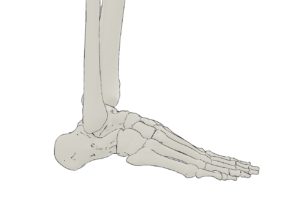足部・足関節のフリーイラストはこちら
変形性足関節症の疫学
有病率は約1%と推定されており、膝OAや股OAほど一般的ではありません。
足OAの最も一般的な原因は外傷の既往で、股OAを有する患者の1.6%、膝OAを有する患者の9.8%、足OAを有する患者の79.5%に1つ以上の関節損傷の病歴が確認されています[2]。
変形性足関節症の症状
足関節の動作時に捻髪音、腫脹、関節の圧痛(特に前内側)、早朝のこわばり感、膝の痛みがみられます。
歩行時に疼痛を引き起こし跛行がみられ、日常生活に大きな支障をきたし症候性足OA患者の69%が生活に支障を来します[3]。
痛みは深部痛であったり限局性であったり、後足部全体の疼痛を伴うこともあります。
症状が強い時は安静時や夜間にも痛みが生じ睡眠障害になることがあります。
足のKellgren & Lawrence分類
変形性関節症では基本的にX線重症度分類であるKellgren & Lawrence分類(K-L分類)が用いられます。
Kellgren & Lawrence分類(K-L分類)
Grade 0:正常
Grade Ⅰ:関節裂隙狭小のないわずかの骨棘形成または軟骨下骨硬化
Grade Ⅱ:関節裂隙狭小(25%以下)あるも骨変化なし
Grade Ⅲ:関節狭小(50%~75%)と骨棘形成骨硬化像
Grade Ⅳ:骨変化が著しく関節裂隙狭小(75%以上)を伴う
Grade Ⅰ:関節裂隙狭小のないわずかの骨棘形成または軟骨下骨硬化
Grade Ⅱ:関節裂隙狭小(25%以下)あるも骨変化なし
Grade Ⅲ:関節狭小(50%~75%)と骨棘形成骨硬化像
Grade Ⅳ:骨変化が著しく関節裂隙狭小(75%以上)を伴う
足関節では足関節用のK-L分類が作られています。
足のKellgren & Lawrence分類(K-L分類)[1]
(ここから各グレードの画像を見ることができます)
Ultimately, we formulated a modified K&L scale as follows:
Grade1: Osteophytes of doubtful meaning on the medial or lateral malleolus, rare tibial sclerosis, joint space width unimpaired;
Grade 2: Definite osteophytes on the medial malleolus, joint space width unimpaired;
Grade 3: Definite osteophytes on the medial and/or lateral malleolus, moderate (<50%) joint space width narrowing – Subgrade 3a talar tilt <2°; Subgrade 3b talar tilt >2° and
Grade 4: Definite osteophytes on medial and lateral malleoli as well as tibio-talar joint margins, severe (>50%) to complete joint space narrowing, constant tibio-talar sclerosis. Based upon this written description, two image examples were sampled illustrating each grade (see Fig. 2).
Ultimately, we formulated a modified K&L scale as follows:
Grade1: Osteophytes of doubtful meaning on the medial or lateral malleolus, rare tibial sclerosis, joint space width unimpaired;
Grade 2: Definite osteophytes on the medial malleolus, joint space width unimpaired;
Grade 3: Definite osteophytes on the medial and/or lateral malleolus, moderate (<50%) joint space width narrowing – Subgrade 3a talar tilt <2°; Subgrade 3b talar tilt >2° and
Grade 4: Definite osteophytes on medial and lateral malleoli as well as tibio-talar joint margins, severe (>50%) to complete joint space narrowing, constant tibio-talar sclerosis. Based upon this written description, two image examples were sampled illustrating each grade (see Fig. 2).
変形性足関節症の保存療法
代表的な介入にはストレングストレーニング、有酸素運動、体重減少(体重を5%以上減らす)、教育、NSAIDsなどによる疼痛コントロールがありますが、OA患者の多くは,これらの非薬理学的治療では効果的に管理できない症状を経験する可能性が高くあります[3]。
運動は関節に負荷をかけすぎないようにAquatic-based exerciseを用いることができます。
変形性足関節症患者は膝の痛みを発症することがあるため、疼痛管理や機能制限による代償性の膝のへの負荷を軽減することが大切です。関節可動域制限は背屈で生じやすく、悪化しない程度に関節可動域維持向上のためにROM訓練をすることもできます。
References
[1]Holzer, N., Salvo, D., Marijnissen, A. C., Vincken, K. L., Ahmad, A. C., Serra, E., Hoffmeyer, P., Stern, R., Lübbeke, A., & Assal, M. (2015). Radiographic evaluation of posttraumatic osteoarthritis of the ankle: the Kellgren-Lawrence scale is reliable and correlates with clinical symptoms. Osteoarthritis and cartilage, 23(3), 363–369. https://doi.org/10.1016/j.joca.2014.11.010
[2]Barg, A., Pagenstert, G. I., Hügle, T., Gloyer, M., Wiewiorski, M., Henninger, H. B., & Valderrabano, V. (2013). Ankle osteoarthritis: etiology, diagnostics, and classification. Foot and ankle clinics, 18(3), 411–426. https://doi.org/10.1016/j.fcl.2013.06.001
[3]Paterson, K. L., & Gates, L. (2019). Clinical Assessment and Management of Foot and Ankle Osteoarthritis: A Review of Current Evidence and Focus on Pharmacological Treatment. Drugs & aging, 36(3), 203–211. https://doi.org/10.1007/s40266-019-00639-y
[2]Barg, A., Pagenstert, G. I., Hügle, T., Gloyer, M., Wiewiorski, M., Henninger, H. B., & Valderrabano, V. (2013). Ankle osteoarthritis: etiology, diagnostics, and classification. Foot and ankle clinics, 18(3), 411–426. https://doi.org/10.1016/j.fcl.2013.06.001
[3]Paterson, K. L., & Gates, L. (2019). Clinical Assessment and Management of Foot and Ankle Osteoarthritis: A Review of Current Evidence and Focus on Pharmacological Treatment. Drugs & aging, 36(3), 203–211. https://doi.org/10.1007/s40266-019-00639-y

